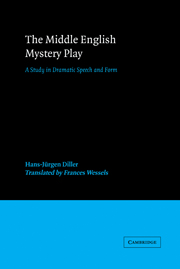Book contents
- Frontmatter
- Contents
- Preface
- Note on texts used
- Abbreviations and special symbols
- Introduction
- Part I The foil: Latin church drama
- 1 Liturgy and drama
- 2 Liturgical point of view surrounding the dramatic core dialogue
- 3 ‘World-containing’ situations
- 4 The dramatization of narrative sources
- Part II The English Creation to Doom cycle
- Notes
- Bibliography
- Indexes
1 - Liturgy and drama
Published online by Cambridge University Press: 04 March 2010
- Frontmatter
- Contents
- Preface
- Note on texts used
- Abbreviations and special symbols
- Introduction
- Part I The foil: Latin church drama
- 1 Liturgy and drama
- 2 Liturgical point of view surrounding the dramatic core dialogue
- 3 ‘World-containing’ situations
- 4 The dramatization of narrative sources
- Part II The English Creation to Doom cycle
- Notes
- Bibliography
- Indexes
Summary
Impersonation and representation
The dramatic character of the Roman liturgy has been much discussed. It would be far beyond the scope of this study to recapitulate that discussion here, especially since it has suffered from a lack of agreement on the definition of ‘drama’ or ‘the dramatic’. Instead of offering my own definition, I propose to discuss the merits of two definitions which have been influential in recent years. The first goes back to Eric Bentley: ‘A impersonates B while C looks on.’ The other has gained currency through the well-known work of Keir Elam and has recourse to the semantics of possible worlds. Elam distinguishes between ‘theatre’ and ‘drama’, where ‘theatre’ refers to the performer-audience transaction, while drama means ‘the network of factors relating to the represented fiction’ (p. 2).
The trouble with these definitions for our purposes is that the first includes too little, and the second too much. Bentley's definition leaves out the ‘network’ of relationships which Elam refers to and thereby makes the notion of ‘looking on’ questionable. Are the children merely ‘looking on’ when Uncle Jim ‘impersonates’ Santa Claus? ‘Looking on’ or ‘watching’ suggest a detachment which seems possible only if more than one person is being represented or embodied. This appears to leave us with Elam's description of drama as a network of factors. For a historical study, however, Elam's definition has the drawback that it is concerned not with texts but with the worlds represented by them.
- Type
- Chapter
- Information
- The Middle English Mystery PlayA Study in Dramatic Speech and Form, pp. 9 - 24Publisher: Cambridge University PressPrint publication year: 1992



